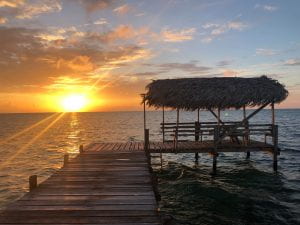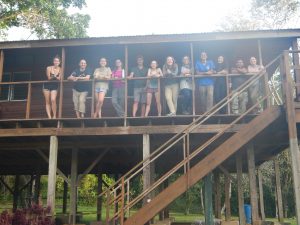This class was nothing short of amazing. While it was taxing (so far from home, so much energy every day,) it was still an incredible experience. In my initial blog, I mentioned that I expected to be wowed- and that I most certainly was. One thing that wowed me: how cool ants and wrasses are! My research was cool, but seeing them and their behaviors first hand was truly something else. I loved seeing my taxa out in the wild! Another thing, my physical capability to live there. Las Cuevas and Glover’s are two fairly simple places to live – minimal internet connectivity, no AC, Clivus (mentioned in my glover’s day one blog,) just to name a few. Not only did I survive, I thrived.
On the topic of thriving, I’ll mention my favorite and least favorite parts. To get it out of the way, clivus was my least favorite part. He was character building, but I could have used a real flushing toilet. My favorite part, however, is hard to put into one single favorite part. So I’ll do two: one personal growth, and one TFB-related. Personal growth wise, this was the first time I have done something totally new and away from family in a while. I was sad and stressed those first couple of days. Once I realized what was happening, I was ecstatic. (Important context here: I am asleep away camp counselor) I realized that I was experiencing what my campers were. They feel this way at camp for the first time, and because my first time was so long ago, I couldn’t know how they feel. Huge personal and camp-professional growth totally unrelated to TFB. On the topic of TFB, my favorite part of the course must have been either excavating the Leafcutter nest or dissecting the lionfish. In these two cases, I got to see my taxa up close and see my research in action_ I researched fungal gardens of Leafcutters and lionfish invasive predation on wrasses, and seeing it IRL after all of that research was like nothing ever before. The personal growth, leafcutter excavation, and dissecting a lionfish are three things I will certainly never forget. I will also never forget our visit to the ATM cave and all of the rich Maya history in the region- I would have loved to go back in time to see the cave being used IRL, but the remnants they left (except the human remains) were still so awesome and fun to see!
Another great part of the course was the ability to compare and contrast the two different ecosystems we visited- the reef and the rainforest. Right off the bat, you can guess they are fairly dissimilar- one is in the air, the other in the ocean, so how similar can they be? Well, the answer might surprise you. Because of the nature of the tropics (more sun in the days and more direct sun) You can find both the reef and the rainforest using it in cool ways. Rainforests have much richer canopies than floors or soils, and reefs are somewhat similar, they are also considered to be “nutrient poor” despite their rich biodiversity. Another favorite comparison of mine to make was connecting my taxa to the opposite ecosystem. I attempted to find the ants of the sea, which could be corals, glass shrimp, or even wrasses, while we determined birds were the wrasses of the sky (not the other way around, according to Dr. Evans.)
Overall, this course was so fantastic, and I highly recommend it for anyone in the future considering applying, you won’t regret it!
Images:







